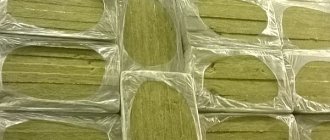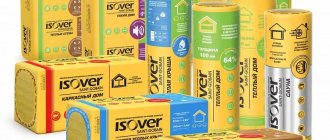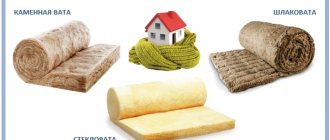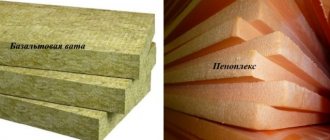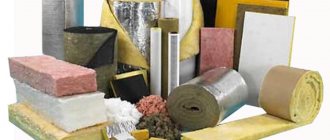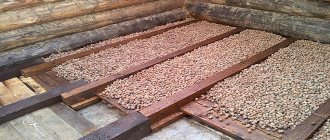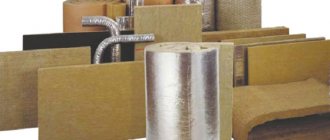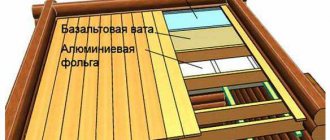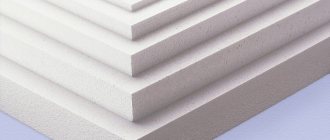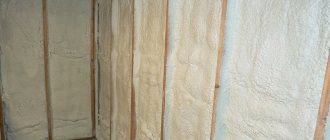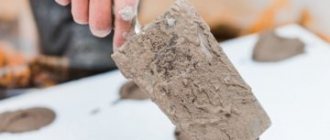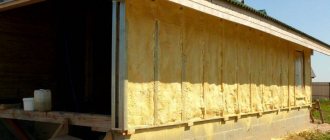Why insulate the floor
Thermal insulation layer is necessary to prevent heat loss from the room. The microclimate in the bathhouse is characterized by high humidity and temperature. In the absence of proper insulation, several problems arise in this case:
- The heat quickly escapes. It becomes difficult to light the sauna. At the same time, the consumption of firewood or other fuel increases significantly. Carrying out all the necessary measures during construction will save money.
- The material of supporting structures is exposed to simultaneous moisture from the inside and cold from the outside. This combination has an extremely negative effect on both concrete and wood. In this case, operating costs increase again, but due to repair costs.
- The bathhouse cools down quickly. Drafts may get inside. Cold air causes spoiled rest or illness.
Proper insulation of the floor in a bathhouse with your own hands allows you to prevent problems, ensure an optimal indoor microclimate and not spend money on the services of professionals.
Non-spillable floor in the steam room
The non-spillable floor in the steam room is made of tongue-and-groove boards and has an organized drain. The boards are laid with a slope towards the drain. The floor drain is a concrete or metal (less commonly) gutter. The slope of the board is small - 1 cm per meter. Do not need anymore.
How are non-leakage floors constructed in a bathhouse - in a steam room or shower/wash room
That is, structurally it is an ordinary wooden floor. Except that you have to make a drain. It is done either at the wall opposite the shelf, or as in the picture above, in the middle.
The insulation of the floor in a bathhouse of this design is similar to that described above. Except that:
- Thermal insulation material must be protected from moisture, which still seeps through the wooden flooring. But you also need to remove the moisture that has already got there. So again we need a membrane with one-way conductivity. It is placed so that moisture is not allowed into the insulation, but vapor is released. Below, by the way, under the insulation, if your soil is open and concrete preparation has not been made with waterproofing laid out, a membrane is also needed. It is nailed as described above.
How to make a drain in a steam room with a wooden floor - There must be an air gap between the top edge of the insulating material and the flooring. It is needed so that the moisture that settles on the membrane can evaporate. A ventilation gap is provided with wooden slats (thickness of at least 20 mm), which are placed across the joists.
How to insulate floors in a bathhouse and with what: floor insulation scheme by joists
In general, the cake is standard. That is, we insulate the floor in the bathhouse according to the usual scheme. The whole difference is in the thickness of the insulation and the presence of a gutter for drainage. And the thickness of the insulation in the steam room is taken taking into account the fact that it needs to be heated as quickly as possible. Therefore, they usually take 50% more layers than for ordinary rooms.
What materials to use
Water will become a problem when insulating the floor. Many materials are not designed for installation in conditions of high humidity. This applies to insulation with high absorption capacity.
For example, it is not allowed to use mineral wool to perform the work. This effective insulation is able to absorb water. When wet, cotton wool stops performing its intended tasks, wrinkles, settles and loses its shape.
- Styrofoam;
- extruded polystyrene foam (or penoplex);
- penoizol, etc.
Styrofoam
Styrofoam balls do not absorb moisture, but be aware that water can accumulate in the spaces between them. In the first winter, the insulation crumbles into individual particles. This is caused by the fact that water freezes inside the foam, expanding in volume (it is the only substance on the planet that expands when cooled).
To prevent problems, insulation of the floor in a bathhouse with foam plastic is carried out using additional materials:
- Vapor barrier. Mounted on the warm air side. Prevents the effect of steam from the bath on the insulation. Available in the form of films or membranes. To more effectively retain heat in the bath, special foil membranes are used. They not only protect the foam from getting wet, but also reflect heat back into the room.
- Waterproofing. Fixed on the cold air side. Prevents atmospheric or ground moisture from entering the insulation. Films and membranes are used as a hydrobarrier. To insulate the floors in a bathhouse on stilts, moisture- and wind-proof membranes are chosen. They prevent drafts.
Insulating the floor in a bathhouse with foam plastic
You can insulate the floor in a hollow with foam plastic, especially under the screed: the floor will be warm, and the foam is not afraid of moisture.
Foam insulation of the ground floor
To do this, the soil is leveled, if it is loose, compacted and left for 30 days. Then 10 cm of medium-sized gravel is poured and compacted, and 10 cm of sand on top, which is also compacted. A film of polyethylene is laid on the sand, and then sheets of foam plastic are placed on it. The sheets are fastened with locks and coated with the same bitumen-polymer mastic or solvent-free polyurethane adhesive. A polyethylene film is again laid on top of the foam, on which the reinforcing mesh is laid. The base for the concrete screed is ready. The floor will be quite reliable and will withstand any load if the thickness of the screed is at least 6 cm. In terms of heat and moisture insulation, it has few equals.
Insulating the floor in a bathhouse with foam plastic
Insulating the floor with foam plastic between the joists
If you are insulating floors between joists, then it is advisable to cut the foam exactly to size, and blow out the inevitable cracks with polyurethane foam: a significant amount of heat escapes into the cracks. In this case, it is possible to use any type of foam, including granular, because boards will be laid on top, and the entire load will fall on them. To improve the waterproofing properties, polyethylene film is also placed under the foam and on top of it. In a steam room, this type of floor insulation can hardly be used, but in a locker room or dressing room it can be used.
Insulating the floor in a bathhouse with foam plastic
Penoplex
The material is a close relative of foam plastic, but without its disadvantages. It costs more, but is distinguished by high strength, quality and resistance to moisture. The thermal insulation properties of these materials are the same.
The choice between them is made depending on the installation method and the expected load. When installing heavy furniture and laying insulation under the screed, extruded polystyrene foam is preferred. It definitely won’t wear out under load (if you choose the right brand for strength).
Insulating the floor in a bathhouse with penoplex allows you to do without vapor barrier and waterproofing. They should be used whenever possible (especially in areas with the highest humidity), but this is not a necessary step.
Insulation under the screed
If the bathhouse is built of brick, most likely the ceilings are made of reinforced concrete. Also, sometimes there is a need to make a floor on the ground. In this case, insulation is performed under the screed. When using this technology, the load on the insulation increases, so you should follow the following recommendations:
- choose material grade PSB-S 35 (foam plastic) or EPPS 35 (penoplex);
- the thickness of the screed is prescribed 30-50 mm (when using the “warm floor” system - more);
- when using polystyrene foam, the screed is reinforced with wire mesh with a diameter of 3-4 mm and cells of 50 by 50 mm.
If it is necessary to insulate the floor on the ground, then the base is not only leveled, but also compacted. The floor pie in this case looks like this:
- compacted soil;
- sand-gravel mixture or medium-sized sand (20-30 cm);
- concrete preparation from lean concrete B7.5—B12.5;
- waterproofing;
- insulation;
- vapor barrier;
- screed with reinforcing mesh.
The concrete floor consists of the following layers:
- reinforced concrete slab;
- waterproofing;
- insulation;
- vapor barrier;
- screed (with or without reinforcement).
Insulation of a bathhouse begins with clearing and leveling the base. All cracks in the concrete floor must be covered with cement mortar. After this, special leveling mixtures can be used. A line is drawn on the wall to mark the finished floor. This is required in order to control evenness.
Waterproofing is placed on the prepared base. It is mounted with an overlap of 10 cm (including on walls), gluing the joints with a special film.
Polystyrene foam or polystyrene foam is laid on glue. The solution is applied only along the edges and to several points in the center. When purchasing glue, it is important to check that it does not contain solvents or other substances hazardous to the insulation. The slabs are installed with the seams bandaged (in a staggered manner). A gap of 1-2 cm is provided between the polystyrene and the wall, taking into account the expansion of the material during operation; this space is filled with damper tape. Before pouring the screed, the slabs are secured to the base using disc dowels.
Installation on joists
Insulation of the floor in a bathhouse on screw piles (or for a wooden structure on any foundation) is most often carried out between joists or beams. Unlike the previous method, here you can choose insulation with less strength, since the material does not take the load from furniture and people.
Expanded polystyrene is mounted between wooden floor joists or between floor beams. The floor pie for a wooden bath in this case looks like this:
- subfloor boards (or plywood, DSP, OSB);
- waterproofing;
- insulation between load-bearing wooden beams;
- vapor barrier;
- clean floor.
The insulation is simply laid between the beams. There is no need to use glue or dowels. But it is necessary to fill the gaps between polystyrene and wood with sealant or polyurethane foam.
Proper insulation of the bathhouse will ensure a comfortable microclimate and extend the service life of the building. An increase in construction costs in this case leads to savings in operation.
And a bathhouse is a room in which even one percent of the required temperature disappears noticeably, so insulating the ceiling here becomes a priority.
Thermal insulation of a brick bath
Foundation
The insulating layer of the foundation will not only increase the overall level of heat saving, but will soften the pressure on the foundation, which leads to increased stability of the structure.
When insulating the foundation, penoplex can be laid out in two layers with a total thickness of 60 mm - depending on the selected category of material.
Floor
Particular attention is paid to the thermal insulation of the bathhouse floor, since the floors are affected by both temperature changes and high humidity.
The thickness of the bathhouse floor insulation with penoplex is calculated based on the thickness of the building walls.
Thermal insulation is produced using the “sandwich” method. The thickness of such a “sandwich”, taking into account the waterproofing layer, is at least 5-10 cm. Additionally, expanded clay can be poured on top.
Walls
To equip high-quality thermal insulation of brick bath walls, a “sandwich” of a double layer of insulation is installed:
- A layer of waterproofing is fixed to the brick base;
- A sheathing is installed on which the penoplex is attached;
- A second grille is equipped on top of the heat insulator, onto which fiberglass and a second layer of insulation are attached;
- The entire structure is covered with clapboard.
This method is used for internal wall insulation. The thickness of the entire structure is 18-23 cm.
Polystyrene foam as an insulation option
For any type of room insulation, many now prefer polystyrene foam. This material is appreciated for
:
- ease;
- compactness;
- ease of installation;
- low cost.
How effective is such insulation and in what cases should foam plastic be used exclusively?
You need insulation of the bathhouse ceiling with polystyrene foam and nothing else if
:
- The ceilings of the room are very low and making them even lower is inappropriate and illogical.
- In rooms where material that does not absorb moisture is needed.
The effectiveness of foam insulation
- a fact proven by time. Heat saving increases significantly, there is no accumulation of condensation, there is no mold, and there are no insects.
Synthetics
Natural gaskets are superior in terms of benefits and the absence of harmful fumes, but man-made materials are considered more durable. They can be used to upholster the attic of a room once and forget about updating the renovation for several years; this procedure will not cause harm if you follow safety precautions and follow the correct scheme for insulating the ceiling in a bathhouse.
There are the following categories of synthetic insulation:
- polymer;
- mineral wool;
- glass wool;
- foil.
The choice of inorganic materials is very wide. Therefore, in order to find out what insulation to use to insulate the ceiling in a bathhouse, you need to look at its thermal conductivity. Products of chemical synthesis, as a rule, have a higher ability to retain heat than organic matter.
But there are ways to arrange structures by combining materials, for example, laying a peat slab or a layer of earth on top of the foam.
But it is necessary to take into account that when the room becomes too hot, inorganic raw materials emit harmful and even toxic substances. Therefore, the answer to the question whether it is possible to insulate the ceiling in a bathhouse with penoplex foam will be negative.
These slabs are ideal for equipping technical, utility rooms (dressing room) or rest rooms where the temperature does not reach high limits.
Insulating a bathhouse ceiling with mineral wool
The main advantage of this material is its cost-effectiveness. Due to low thermal conductivity, very little raw material is required - 10-15 cm. Slag fiber boards are especially convenient for installation, as they lend themselves well to cutting and transformation.
Unlike natural raw materials, such blocks are not attractive prey for rodents.
The choice to insulate the bathhouse ceiling with basalt wool will be the most optimal, since the material:
- does not deform;
- does not absorb moisture (with special treatment);
- does not burn;
- does not require replacement for many years.
Photo from the site Uvk.vn.ua
There are several subtleties in how to insulate the ceiling in a bathhouse with mineral wool. Without protection and special impregnations, a pressed mineral slab is hygroscopic, so first of all you need to think about protecting the blocks.
- Before laying the sheet on the boards, it is necessary to lay a layer of vapor barrier (polyethylene or foil with metallized layers to the coating).
- Then a pliable material is pressed between the beams.
- Another sheet of foil protection is attached on top with the metal layer facing out.
Several other types of wool are also used - diabase, dolomite, slag. They are superior to folk remedies in terms of their effectiveness and modernity.
Photo from Mastergrad.com
Pros and cons of the material
Styrofoam
- nothing more than foamed polymers that formed capsules with gas at high temperatures and retained their shape when cooled.
As a substance formed by gas, polystyrene foam has a number of excellent insulating properties.
:
- ease;
- moisture resistance;
- durability;
- sound insulation;
- resistance to shrinkage.
In addition, in price lists, foam plastic consistently occupies a position among the cheapest building materials. Just what you need for economical and quick insulation.
However, don’t get too fascinated and think that polystyrene foam is perfect. Of course, it also has disadvantages, but whether or not to pay attention to the disadvantages of this insulation is your choice.
The disadvantages of polystyrene foam are:
:
- flammability (due to the nature of its formation - using gas);
- not too long service life, which may be further shortened due to violation of installation technology;
- unsuitability for insulation of wooden premises. In practice this is possible, but only if there is high-quality ventilation;
- fragility;
- release of toxic substances during combustion that can cause paralysis of the respiratory tract;
- poor quality of some brands of polystyrene foam produced in artisanal conditions.
Features of the use of penoplex (depending on the category)
The types of this material presented on the modern market can be divided into at least three categories. This will make it easier to calculate the thickness of the insulating layer in the future.
“K” series material has improved water-absorbing properties.
It is used to improve the thermal insulation properties of the roof (this is important, since the roof accounts for up to 25% of the total heat loss).
Series “C” is nothing more than 35 density penoplex, used mainly for thermal insulation of walls and ceilings.
Thermal insulator of the “F” series - as can be seen from the markings, is used for foundation insulation work, due to its increased resistance to the effects of a bioactive environment.
In simple terms, the foundation is in the soil - this is a fact, it is affected by various soil chemicals.
The heat insulator of the “F” series resists the effects of these substances, which makes it possible to increase the durability of the heat insulator and the structure itself.
Are polystyrene foam and polystyrene foam the same thing?
The insulation of the ceiling of a bathhouse with foam plastic can be somewhat diversified, while remaining faithful to the choice of this particular material.
You couldn't help but hear about an improved type of polystyrene foam - polystyrene foam. Essentially, these are the same plates made of capsules filled with a gaseous substance, only stronger, stronger, better.
Let's analyze the qualities of polystyrene foam
:
- it is not as fragile as polystyrene foam; even with not very careful transportation, the corners of the polystyrene foam plate remain intact;
- this material does not ignite as quickly as polystyrene foam filled with highly flammable gas;
- The service life of expanded polystyrene is from 15 to 35 years, polystyrene foam is from 10 to 20.
As for the price, expanded polystyrene is only 5-10% more expensive than its “big brother”.
Technology
No matter how good the material is, failure to adhere to the accuracy of the installation technology can, over time, negatively affect the quality of heat conservation.
Therefore, having prepared the necessary material, carefully study the step-by-step instructions
.
Frame installation
Required
:
- foam sheets;
- metal profile or wooden blocks 50x50;
- film for vapor barrier.
Stages
:
- Clean the ceiling from dirt and dust, eliminate unevenness, if any. Treat the surface with an antiseptic.
- Remove electrical wiring. To do this, use a special protective corrugation.
- Attach beams or a profile to the ceiling at a distance of 50 cm. Make sure that the shape of the attached beams takes on the appearance of a large cage, each cell of which should correspond in size to the foam sheet.
- Install foam plastic using dowels or glue.
- Treat joints and cracks with polyurethane foam.
- Attach a vapor barrier layer to the insulation.
- Finally, start installing drywall, wood or other material that matches the overall interior.
Adhesive mounting option
Required
:
- sheets of foam plastic in an amount corresponding to the total area of the ceiling;
- adhesive composition.
Stages
:
- Clean the ceiling, treat it with an antiseptic and prime it for a better bond between the glue and the surface.
- Prepare an adhesive composition or use a ready-made one.
- Apply glue to the foam sheet (in continuous lines along the edge and in splashes in the center of the board). Press the foam sheet as firmly as possible against the ceiling and hold for a few seconds.
- If you are insulating the ceiling using polystyrene foam, then all the sheets should be prepared in advance: scratch with an iron brush along the working side (the one on which you will apply the adhesive).
- Start gluing the sheets from the middle of the ceiling in a checkerboard pattern.
- For greater reliability, the foam sheets can be additionally attached with dowels after the glue has dried.
- Glue the reinforced mesh on top of the foam and putty.
So is it worth it to insulate with polystyrene foam?
And yet, there is an opinion among experts that all the disadvantages of polystyrene foam are more far-fetched than real.
The popularity of foam sheets among developers has no equal. And if we talk about insulation as a low-cost, simple and fast process, then it is hardly possible to find a better material.
Insulating the ceiling of a bathhouse with polystyrene foam can be done without any problems by a non-professional, a person who has taken up repair work for the first time.
However, when buying foam boards you need to be very careful
so as not to bring a pile of small balls instead of whole sheets. Use products only from trusted manufacturers.
The construction of a bathhouse is a rather responsible process, and therefore, if you want the procedures to bring exclusively benefits to the human body, and maintaining the structure does not cause unnecessary trouble, you should approach such a matter as insulating the bathhouse as seriously as possible.
At the moment when the box is already standing and the time has come to carry out insulation, quite logical questions arise: how, and with what? This article will tell you how to competently approach this issue, as well as which material – polystyrene foam, sawdust or clay – to use for insulation.
Using polystyrene foam as insulation
Polystyrene foam is a kind of air bubbles enclosed in a thin polystyrene shell. Due to the fact that the main part of the material is air (about 98%), foam is characterized by excellent thermal insulation properties, which is why it is widely used as a material.
It should be noted that its popularity is justified not only by its high thermal insulation properties. There is a whole list of its positive qualities:
- long service life - up to 50 years in normal conditions, up to 20 years in unfavorable conditions (with large temperature differences);
- hydrophobicity. Polystyrene foam is capable of absorbing about 0.2% moisture per day, in other words, it practically does not absorb it;
- biological neutrality and stability. The temperature at which this material is able not to collapse and not release any substances is from -60 0 C to +95 0 C. In addition, the safety of foam plastic is also confirmed by the fact that it is widely used for products such as food packaging for products or in children's toys;
- relatively low cost of this material. However, absolutely cheap offers must be treated with caution, since such products must be accompanied by appropriate certificates. Remember that all materials the production of which was carried out in violation of the technological process can be quite dangerous;
- Styrofoam is very easy to work with. It is characterized by low weight, cuts well, and also does not require additional protective equipment or devices;
- There is absolutely no environment in which fungi, spores or bacteria can multiply. Not damaged by insects.
In addition to its advantages, foam plastic is characterized by the presence of disadvantages, in particular its complete impermeability to steam and air. Thus, for rooms with thermal insulation made of foam plastic, it is necessary to develop a good one.
Also, there is one more negative quality of this material: rather weak resistance to external mechanical influences. That is why, if polystyrene foam is used to insulate the foundation, additional reinforcement will be required, as well as a protective coating.
Is it possible to insulate a bathhouse using polystyrene foam?
Drawing conclusions from all of the above, it can be noted that it is allowed to use polystyrene foam as insulation, however, in the steam room of a Russian bath, as well as in the steam room of a Finnish sauna, it is strictly not recommended. Remember that the temperature conditions in these rooms are such that the completed thermal insulation can heat up to 95 0 C or even higher, and after that the foam will lose its chemical stability.
As a rule, polystyrene foam is recommended for thermal insulation of walls outside, or walls inside the room itself, but which do not go outside, since this is due to the high level of thermal insulation properties of polystyrene foam. If you install it on the wall from the inside, then the outer wall will be completely insulated from heat. In this case, condensation will form inside the wall. Thus, in cold weather it will freeze/thaw, which will lead to instant destruction of the building material. That is why, if you insulate a bathhouse with foam plastic, then it must be done exclusively from the outside, or its internal partition, but not from the side of the steam room.
Direct insulation of walls from the outside with foam plastic is characterized by fairly good reviews: in the summer the room is cool, in the winter it is warmer, material costs for maintaining a comfortable microclimate are significantly reduced. Another added benefit: the room becomes much quieter. However, a well-functioning ventilation system is very important for excellent well-being, since excess moisture does not escape through the walls.
As for the bathhouse, there is simply no need to insulate a wooden bathhouse using polystyrene foam: wood itself has good heat-insulating characteristics. If we talk about a bathhouse made of bricks or building blocks, in this case it is very possible to insulate this room using polystyrene foam.
Using clay with sawdust as insulation
Clay with sawdust is characterized by unique thermal insulation properties and is used not only as insulation, but also as waterproofing. Please note that the waterproofing and thermal insulation properties of clay, in addition to sawdust, are quite often used for arranging bathhouses. It is this material that is not subject to destruction, including the conditions of probable contact with hot steam. Not all building materials used for insulation and waterproofing can effectively cope with this factor.
The main advantage of such insulation as clay with sawdust is the ability to use this option in almost any area: both where there is a constant high temperature and where the temperature can drop to critical levels. Clay with sawdust can not only prevent heat loss in winter, but also keep it pleasantly cool in summer. Moreover, in addition to excellent thermal and waterproofing characteristics, this material is considered quite durable and also environmentally friendly. Most private developers prefer the use of clay with sawdust solely because of its safety, since not all modern building materials can be trusted for their direct use in the process of finishing the interior of a room.
However, let's note that fixing a bathhouse using clay and sawdust is far from the easiest way to insulate a room. Remember that the effectiveness of insulation with clay and sawdust is influenced by a fairly large number of factors. In particular, it should be noted that it is very important to prepare the mixture correctly, since if the proportions are violated, the finished material will not set well and thus crumble very quickly. Also, the insulation on the walls should be applied correctly in order to achieve maximum effect.
Important! Basically, clay with sawdust is used to insulate the ceiling, that is, the area that will not be subject to significant load in the future.
If it is planned, it is necessary to use material such as reeds or straw instead of small sawdust. As a rule, it is preferable to use reeds, which should be mixed with clay. The fact is that in this case, straw and reeds will serve as additional reinforcement, thereby increasing the load-bearing capacity, as well as the high level of strength of the entire insulating layer.
Let's note that insulating a bathhouse using clay and sawdust is an old, time-tested method that is characterized by highly reliable results. However, such a process is very labor-intensive, and it is quite difficult to cope with alone.
Technological process of insulating a bath using clay and sawdust
The first thing that needs to be done before laying the insulation is to treat the surface on which the installation will be carried out with cement mortar or plaster. After the base has completely hardened, you should begin laying the insulation.
If you plan to use a wet mixture, then it is recommended to make wooden formwork so that the mixture is poured into special boxes, the width of which should be approximately 1 m. In turn, which can keep the mixture from spreading, and will also form a more reliable layer of insulation.
After this, you should start pouring a thick mixture of clay mixed with sawdust. The insulation must be poured progressively, box by box, leveling the surface of each of the new fragments. After the mixture is completely poured, the surface must be completely frozen. At the moment of drying, peculiar cracks may appear, which therefore require grouting with a clay solution. This method of insulation is considered the most acceptable exclusively at the stage, since it is quite dirty. If the structure is already ready, it is recommended to use ready-made clay slabs, as well as wood waste. This will significantly reduce the risk of contamination of the surrounding surface.
Insulating the floor in a bathhouse with your own hands is very important.
To underestimate this part of the arrangement of the premises means finishing the work poorly, since then you will be haunted by two problems:
- Heat loss through a floor surface with high thermal conductivity. Consequently, the cost of heating the steam room will increase significantly.
- The burning contrast of the cold floor and the surrounding hot air. This is not only discomfort for your body, but also subsequent condensation, which can lead to mold and rotting of the boards.
Floors can be concrete or wood. Based on this, we will consider the most convenient ways to insulate them.
Insulating the foundation with foam plastic
Since polystyrene foam has excellent thermal insulation properties and is not afraid of moisture, it is successfully used for thermal insulation of foundations. True, to protect it from mechanical loads, a protective partition is needed. It is made either from boards, a cheaper but also much less durable option, or from brick (a half-brick wall).
Insulating the foundation with foam plastic
For loams and clayey soils, insulating the foundation with polystyrene foam is an almost ideal option. Due to the fact that polystyrene foam almost does not absorb water, it protects the foundation from winter and spring heaving: it simply does not allow water to seep through and be absorbed into the foundation material. It is not recommended to use polystyrene foam only if flooding often occurs with a high groundwater level: water can seep under the insulation layer, because perfect tightness is almost impossible to achieve.
Scheme of foam insulation of a strip foundation
With simple foundation geometry, foam slabs are most often chosen. For central Russia, their thickness should be at least 5 cm. But for better thermal insulation in the corners of the foundation, it is better to lay slabs 10 cm thick - in these places the heat loss is the most significant.
Preparatory work for insulating the foundation with foam plastic
The soil around the foundation is removed to the freezing depth (preferably a little lower), the walls are cleaned and primed. You can buy a primer on the market, or make it yourself: you will need molten bitumen, to which you need to add the same amount of diesel fuel or gasoline. Apply the resulting mixture to the foundation and wait until it dries (about 1 hour). A layer of waterproofing must be applied to the primed foundation. This can be liquid rubber (applied with a brush) or rolled bitumen materials (fused using a torch). Then they begin installing the foam.
Installation of foam plastic slabs on the foundation
It is better to lay the bottom row of slabs on a rigid base. If you are just planning a foundation, you can make a special ledge on which the foam plates will rest. If the foundation is already in place, but there is no protrusion, the gravel pad on which the foundation itself stands can serve as a stop.
Foam boards must be secured either with bitumen-polymer mastic or with polyurethane glue. But the glue should not contain acetone, gasoline and toluene, as they destroy polystyrene. The adhesive is applied pointwise or to the entire surface of the slab, but the joints must be glued. Some manufacturers make slabs with an L-shaped lock (this also needs to be lubricated with adhesive), which makes the connection of the slabs more airtight and reliable. With this connection, cold bridges practically do not form and the tightness of the entire insulation becomes almost ideal.
Grooved foam (with selected quarter) - avoids the appearance of cold bridges
Sometimes it is recommended to lay the slabs in two layers, shifting the seams relative to each other - in this way, losses through the joints of polystyrene slabs are also reduced. But this method has its opponents: they say that water will leak between the two layers of foam. Then the thermal insulation properties will deteriorate significantly. This possibility, of course, exists, especially with vertical soil displacements (shrinkage), but how great it is is difficult to judge.
After the foam has been laid around the entire perimeter to the required thickness, you need to apply another layer of waterproofing material on top (the same bitumen roll materials or liquid rubber). You can already build a protective brick wall on top. Sometimes boards are used. A good option is geotextiles. It also copes very well with loads from soil (it is laid under asphalt when constructing highways). Other options are possible. The main thing is to protect the foam from soil loads.
The last stage of thermal and waterproofing of the foundation (this is exactly how the result turns out if you use polystyrene foam) is the installation of a blind area. In general, thermal insulation of the foundation with foam plastic is quite a troublesome task, but as a result, your foundation is protected from moisture, and you don’t have to worry about soil heaving, and you spend much less on heating.
Concrete floor
Insulation of the concrete floor in the bathhouse occurs after the construction of the entire building.
To achieve a high-quality effect, you can use the following materials:
Expanded clay
This material is made by short-term firing of low-melting clay. The technical characteristics of expanded clay allow its use in both concrete and wooden coverings. And the low price is an additional argument in its favor.
To ensure high-quality installation of this insulation, the following instructions will help you:
- We calculate the approximate load on the base in order to know the required thickness of the future insulating layer.
Advice: never mix expanded clay with concrete. Cement does not have such low thermal conductivity and moisture resistance, so the final result will be compromised.
- We lay a layer of waterproofing. A polyethylene film three millimeters thick is ideal, and at the joints we fasten it with mounting tape. We draw out the edges so that they lie on the wall. After filling the insulation, all excess is cut off.
- We install a reinforced grating on top and fill it with cement mortar.
- After complete hardening, it is ready for use.
Glass bottles
This is the cheapest insulation of floors in a bathhouse, since it does not require the purchase of the insulation itself. You just need to collect the spent empty bottles. In addition, not only glass, but also plastic eggplants are suitable.
The trick is that we will create a warm, sealed air cushion in the concrete surface.
Installation of this design is also simple:
- We wash and thoroughly dry the prepared containers.
- We lay them on a base prepared for concrete screed.
- Fill everything with liquid cement mortar so that it covers the walls of the bottles.
- On top, after drying, we apply a finishing screed from a more durable mixture.
Styrofoam
This material has a number of remarkable qualities, thanks to which it is used not only for
- Low price. Not as low as when using essentially discarded bottles, but much lower than many other insulation materials.
- High heat-saving properties due to the presence of many air bubbles in its structure.
- Noise insulation.
- Fire safety. It is a self-extinguishing substance and does not release toxins during combustion.
- Service life more than fifty years.
- Absence of rotting processes, shrinkage and other age-related deformations.
- Ease of installation, which is greatly facilitated by the light weight of the material.
Installs equally well under the screed and under the boards:
- Layer of waterproofing layer.
- We lay foam plastic slabs on top of it in a checkerboard pattern. This will make the design more reliable.
- We close the gaps with polyurethane foam or waste material.
- We install a metal grating and pour a cement screed.
- The hardened floor can be put into operation.
Insulate the ceiling in a bathhouse with penoplex - All about insulation and energy efficiency
Recently, penoplex (extruded polystyrene foam) has become very popular among synthetic thermal insulation materials. It is made by pressing molten foam plastic using a special molding nozzle (nozzle). Under the influence of high temperature and pressure, the structure of the material becomes finely porous with isolated cells measuring 100-200 microns. Thanks to this, it is durable and has high thermal insulation properties.
Penoplex for bath insulation
Among the main advantages of the material for insulating baths are:
- Moisture resistance. In a day, a heat insulation slab absorbs less than 0.4% of its volume, and in a month it can absorb up to 0.6%. Moisture penetrates only into the top layer; the inner filling remains dry, even if the foam sheet is completely immersed in water. Thanks to this factor, the material is not subject to mold and rotting.
- Low thermal conductivity. This property is ensured by the special structure of penoplex. The heat conductivity coefficient is 0.03 W/m and is considered the lowest among insulation materials.
- Strength. Due to the homogeneity of the material, which is achieved by the extrusion method, it is able to withstand significant mechanical loads. At 10% linear information, its strength is 0.2 MPa. In order not to damage its integrity, when insulating the floor, you need to ensure that the surface is even.
- Vapor tightness. This indicator for penoplex is close to roofing felt. Therefore, it is often used to insulate bath rooms where high humidity is maintained.
- Ease. The density of the material is only 25-32 kg/meter 3. It is often used for thermal insulation of roofs, since it does not weigh down the structure. Because of this property it is easy to install.
- Easy to install. Penoplex for bath insulation is cut with a regular construction or stationery knife. Thermal insulation with its help can be easily carried out independently.
- Durability. Some manufacturers provide a material warranty of up to 50 years.
- Chemical resistance. The heat insulator is not affected by alkalis, water-based paints, saline solutions, alcohol compounds, bleach, ammonia, carbon dioxide, propane, butane, various oils, freons, concrete mixtures. However, it must be taken into account that under the influence of formaldehyde, diesel fuel, gasoline, acetone, methyl and ethyl acetate bases, enamel and oil paints, the physical and technical characteristics of penoplex deteriorate. Some formulations can even dissolve the material.
- Soundproofing. After insulating the roof and walls, you will not hear the sound of rain or the roar of a busy highway. Noise protection indicator - 41 dB.
- Temperature resistance and stability. The operating temperature of the heat insulator is from -100 to 75 degrees.
As for the disadvantages of the material, we can highlight the average flammability rate and the release of toxic vapors during combustion. For this reason, before thermal insulation, it is treated with special fire-fighting compounds. Some manufacturers offer insulation already impregnated with fire retardants.
Due to its physical and technical properties, extruded polystyrene foam is widely used for insulating strip foundations under steam rooms, floors, roofs and walls. The log house is usually thermally insulated with natural materials. Therefore, penoplex is used for the most effective insulation of frame and brick structures.
Standard slabs are made 60 cm wide and 120 cm long. The thickness can be from 2 to 15 cm. It must be selected depending on the purpose and climatic characteristics of the region of use.
Be sure to purchase certified products in specialized stores. The quality of the material, its environmental friendliness and performance characteristics depend on this. The cost of penoplex, depending on its thickness, can vary from 3900 to 4300 rubles per cubic meter.
Thermal insulation of the bathhouse foundation with penoplex
It is necessary to start the process after thoroughly waterproofing the base using bitumen mastic. To securely fix the sheets we use acrylic glue.
We carry out the work in the following sequence:
- We apply five to six dots of acrylic glue to the first slab and fix it from the bottom edge.
If desired, you can use acrylic glue for leveling. After backfilling, it is also advisable to insulate the blind area.
Scheme of insulating the base of a bathhouse with penoplex
The plinth is the thinner part of the foundation to which the walls of the structure are attached. Therefore, the durability of the building depends on the quality of its thermal insulation.
In the process we adhere to the following sequence:
Thanks to the hydrophobicity of the heat insulator, the steam room will be reliably protected from moisture.
Thermal insulation of bathhouse floors with penoplex
If you decide to thermally insulate a concrete floor in a steam room, then you can use this insulation in all rooms.
We carry out the work in the following order:
- We cover the foundation pad with bitumen mastic in two layers.
There is a lot of controversy regarding the use of this material for thermal insulation of wooden flooring in steam rooms. As for the technical properties of penoplex, it can withstand temperatures up to 75 degrees, and therefore it is strictly prohibited to use it in a steam room, even if it is treated with a fire-retardant compound. But for insulation in the rest room and dressing room, it is considered the most suitable due to its good moisture resistance.
We carry out thermal insulation following the following algorithm of actions:
- We cover the logs and the space between them with a vapor barrier membrane. You can use aluminum foil, kraft paper or plastic wrap for this.
Before laying, wood for finishing the floor must be thoroughly impregnated with several layers of fire retardant and antiseptic.
Insulation of bathhouse walls from the outside with penoplex
Due to the operating temperature range of the material, insulating the bathhouse with penoplex from the inside is not allowed. Extruded polystyrene foam is usually used externally for frame or brick baths.
The procedure for thermal insulation of walls in a bathhouse with penoplex looks like this:
- Cover the surface with two layers of primer.
Please note that glue for attaching the material can only be used based on cement, polyurethane or bitumen.
Bathhouse roof insulation scheme
Penoplex is not recommended for insulating the ceiling of a steam room due to the high temperature effect. However, they are often used to thermally insulate the roof of a bathhouse, especially if the attic space is used or adapted as an attic.
To ensure high-quality insulation of the bathhouse roof with penoplex, we adhere to the following instructions:
- We fix the vapor barrier membrane with an overlap of 15 cm and glue the joints with sealing tape.
Do not forget to treat all wood with fire retardants and antiseptics before carrying out work. Penoplex must also be impregnated with fire-fighting compounds.
Proper use and proper installation will ensure reliable thermal insulation of the steam room. Moreover, you can implement it yourself, even without construction skills. The main thing to keep in mind is that it is not recommended to insulate the walls of a bathhouse from the inside with penoplex. The material begins to release toxic fumes already at 75 degrees.
11.02.2019
We suggest you familiarize yourself with How to calculate the distance for a bathhouse from the fence: regulatory requirements, how many meters between the bathhouse and the fence
The Russian bathhouse does not lose its popularity, and at the same time it must be built in compliance with the relevant norms and rules. Therefore, the question of how to insulate a bathhouse remains very relevant.
Proper thermal insulation of the bathhouse will help to significantly reduce fuel costs, improve the quality of the procedure, and keep the building itself in good condition for a long time, especially if the bathhouse is used all year round.
Since ancient times, Russian baths have been insulated using natural materials - moss, tow, bast, etc. Nowadays, it is better to use artificial insulation. They are durable, easy to install, and environmentally friendly.
Wooden floors
Insulation of a wooden floor in a bathhouse is even less demanding than in the case of concrete. In addition to the unusual bottle method, all insulation materials used in cement pavement can also be used under boards.
This is due to the installation technology:
- We install wooden logs on the rough prepared base.
- We lay insulating material between the joists. This can be expanded clay, polystyrene foam, mineral wool, penoizol, polyurethane, etc.
- We install waterproofing to protect against possible moisture ingress from above.
- We install the boards, fixing them with nails to the joists.
Separately, you should consider insulation such as mineral wool, which is not suitable for lining under a concrete layer, but shows itself perfectly in a wooden structure:
- The lowest thermal conductivity coefficient is about 0.04 W/mK.
- Non-flammability. Not afraid even of open fire sources.
- Inert to household chemicals.
- High sound insulation.
- Ecological cleanliness. This material is made from rock minerals, which makes its use absolutely harmless.
- Durability. It is not subject to rotting, corrosion, attack by pests and mold.
Despite not the lowest price, such or a sauna.
Underfloor heating system
Another option for insulating the flooring in a bathhouse is installing a heated floor system. In this case, you can choose a design based on electric heating elements or water pipes.
Such floors can not only make the floor warm, but also heat the entire room. Therefore, if they are used in a steam room, they can participate in creating the necessary environment. Their location in other rooms of the building will make it possible to move comfortably barefoot.
They are installed in the same way as other insulation materials under reinforced lattice and screed in a concrete floor and between joists under boards in a wooden floor. An important addition is the need to install heat-insulating material under the system to prevent heat loss into the ground.
Features of bath insulation with foam plastic
In addition to high thermal insulation characteristics, among the main advantages of this insulation are:
- Durability
. Under conditions of constant exposure to an aggressive environment, the material lasts about 20 years. At normal temperature and humidity, the service life is almost 50 years. - Moisture resistance
. Polystyrene foam practically does not absorb moisture. - Structure stability
. The insulation can withstand temperature changes from -60 to +95 degrees without collapsing or releasing toxic substances. - Biological neutrality
. In addition to the field of thermal insulation, it is even used in the food industry and the production of children's toys. - Relatively cheap
. This material has a low price compared to other synthetic heat insulators. - Light weight
. Due to this, it is widely used for insulating bathhouse ceilings.
In addition, foam plastic does not require additional processing, is easy to cut, quickly installed, and does not rot.
However, with so many advantages, this material has a significant drawback - it burns, releasing toxic substances. Many manufacturers add special non-flammable polymers to it and claim that such foam melts and does not support the combustion process. Judging by the technical characteristics of such foam, the melting point of the insulation is about 95 degrees, and the spontaneous combustion temperature is more than 490 degrees.
If we talk about the level of heat conservation of polystyrene foam in bathhouses, then a standard 6-centimeter layer of insulation can replace 10 cm of mineral wool, 20 cm of wood, 0.5 meters of foam concrete, 0.8 meters of brickwork, 2 meters of concrete. Thanks to these characteristics, the material is very popular for external thermal insulation of baths.
It is necessary to buy polystyrene foam from well-known and trusted manufacturers. Cheap and uncertified material may contain toxic substances.
Is it possible to insulate a bathhouse with penoplex?
What is required from a bath insulation?
If you have already answered your question: “to insulate or not to insulate a bathhouse” in favor of “insulate”, you will have to conduct a serious study of the insulation materials existing today, their characteristics, prices and ease of working with them, study reviews about them. Find out which one Suitable for floors, which is suitable for walls and ceilings.
First, let's consider the main tasks that thermal insulation material for a bath faces:
- Resistance to high temperatures - the bathhouse is a zone of high temperatures and the heat insulator should not lose its qualities when interacting with them;
- Non-toxicity - under the influence of all factors in the bathhouse, the insulation should not emit substances that have a harmful effect on the human body;
- Moisture resistance - the thermal insulator should not absorb moisture, and also should not lose its insulating properties in conditions of high humidity;
- Durability - you are unlikely to want to replace insulation more often than necessary;
- Environmental friendliness - insulation should not contain substances that interact poorly with the human body or have a harmful effect on human health;
- Price-quality ratio - this is how it is now customary to evaluate any product on the market, no matter what it relates to.
Brief overview of existing materials on the market
In the old days, it was customary to insulate baths with various natural heat insulators - tow, jute, felt, moss. But the use of these substances is fraught with the appearance of various kinds of insects, mold, fungi, and dampness. In today's construction, there are a number of new generation thermal insulators that can be used for insulation. Reviews about modern insulation systems speak for themselves.
Penoplex is extruded polystyrene foam. A modern material consisting of air and foamed polystyrene. Due to the combination of its properties, it is very popular as a thermal insulator for various rooms. In a bathhouse, it can be used to insulate the floor, as well as all rooms except the steam room.
Basalt wool is a modern insulation based on basalt volcanic rocks. 90% consists of air. It has very high heat resistance and is completely non-hygroscopic. It is resistant to high temperatures, highly environmentally friendly and absolutely non-flammable and non-toxic. It can be used for thermal insulation of the ceiling and walls in a steam room.
Expanded clay is a modern insulation material that can be successfully used to insulate the floor of a bathhouse. Also, to insulate the ceiling, a method is used when the attic is filled with expanded clay. It is obtained by firing natural intumescent clays, which gives it its special porosity. Excellent thermal and sound insulator. The bulk substance is produced in the form of oval granules of various sizes. It has an extremely low specific gravity, which makes it indispensable when it is necessary to reduce the load on the structure. It is added to concrete, thus “diluting” its excess weight. Perfectly absorbs excess moisture.
The list of possible insulation materials is impressive and we present only a few, especially popular ones.
Main characteristics of penoplex
Each of the above materials is good for its tasks and its areas when insulating a bath. Some materials are suitable for floors, others for walls and ceilings. Some can even be used in a steam room, others are recommended to be placed in all bath rooms except the steam room. Let's take a closer look at penoplex as insulation for a bathhouse floor.
Reviews about it are very favorable. We can say that today penoplex is one of the most used thermal insulators both for baths and for any other types of premises. This happens due to the combination of its following qualities:
High thermal insulation properties;
- Environmental friendliness;
- Moisture resistance and heat resistance;
- Non-toxic;
- High resistance to compressive loads (which is important when insulating the floor);
- Light weight (which makes it easy to install);
- Well amenable to mechanical processing;
- Resistance to mold and mildew;
- Resistance to temperature changes;
- Affordable price;
- Durability.
The disadvantages of expanded polystyrene include the following:
- Has low strength;
- When burned, it emits highly toxic smoke, which can cause serious damage to health or even death;
- Destroyed by some chemical solvents.
As we can see, the list of useful qualities of penoplex largely corresponds to the above list of necessary characteristics of insulation for a bathhouse. It can successfully insulate the floor in a steam room. It is also ideal for thermal insulation of walls and ceilings in all rooms except the steam room. Insulating the ceiling and walls in a steam room with penoplex is not recommended - its properties are lost at temperatures from -50 degrees to 75 degrees Celsius.
To insulate walls, steam penoplex can only be used if a foil layer is placed behind it, protecting it from exposure to excessively high temperatures. Thermal insulation of the steam room ceiling with polystyrene foam is categorically not recommended - the material may come into contact with the pipe, which heats up to 200 degrees Celsius, which can create a fire hazard. Therefore, for these tasks, as a rule, basalt wool is used, which is an absolutely non-flammable material.
But the floors in the steam room can be safely insulated - penoplex is ideal for this. Just be sure to choose a brand of material with high compressive strength - remember that when insulating the floor, such loads will be constant.
conclusions
Reviews about penoplex are unanimous - this material can be successfully used to insulate almost all rooms in a bathhouse, except for the ceiling in a steam room. Insulation of the walls in the steam room is possible, but only when using a foil layer on top of the thermal insulator. Penoplex can be used in other areas with virtually no restrictions.
Bathroom insulation technology with foam plastic
If you decide to use this material for thermal insulation, then you need to take care of high-quality ventilation of the room in advance. Polystyrene foam does not allow steam and air to pass through at all. Also keep in mind that they are strictly forbidden to insulate the steam room from the inside due to exposure to high temperatures. It is often used to insulate brick baths, since wood itself has high thermal insulation characteristics and at the same time “breathes.”
Instructions for insulating the foundation of a bathhouse with foam plastic
Polystyrene foam is the optimal material for thermal insulation of the strip foundation of a brick bathhouse on clay soils. We carry out work in the following sequence:
- We remove the layer of soil around the base to the depth of freezing.
- We prepare a mixture of molten bitumen and gasoline in equal parts.
- We clean the walls and open them with the prepared solution. You can also use a primer.
- After drying, apply liquid rubber to the surface with a brush or fuse rolled bitumen with a burner. This is necessary for waterproofing.
- We fasten the foam boards from the bottom up, fixing them with bitumen-polymer mastic.
- The joints between the elements are also additionally lubricated with an adhesive composition.
- After complete coverage with foam, we apply a second waterproofing layer.
- We make a protective wall from bricks, boards or geotextiles. It will protect the insulation from the gravity of the soil.
- We install a blind area.
Please note that for installing foam boards, you can use polyurethane or other glue that does not contain toluene, acetone and gasoline.
Rules for insulating the floor in a bathhouse with foam plastic
This material is not used for thermal insulation between logs in a bathhouse due to high temperatures.
It can only be safely insulated on a ground floor under a cement screed. During the process we follow these instructions:
- We level and compact the soil.
- Fill in a layer of fine gravel about 10 cm and compact it thoroughly.
- We make a mound of sand of the same thickness on top and compact the layer.
- We lay a waterproofing film. You can even use polyethylene for this.
- We install foam plastic slabs about 20 cm thick, fastening them with polyurethane glue without solvents or bitumen-polymer mastic.
- Re-lay a double layer of waterproofing.
- Pour concrete with an admixture of foam chips or expanded clay in a layer of 5 cm.
- After complete drying, we lay a mesh of metal reinforcement.
- We pour another 5-centimeter layer of concrete with a slope towards the drainage area and wait for it to dry.
- We lay floorboards.
Such flooring will conserve heat as efficiently as possible and will not succumb to the aggressive effects of humidity.
Specifics of insulating bath walls with foam plastic
It is strictly forbidden to insulate the walls inside a steam room with this material for several reasons: the insulation cannot withstand high temperatures, due to air tightness, the dew point shifts, which leads to the formation of condensation in the room.
However, polystyrene foam is suitable for external insulation of walls of brick structures. The work is carried out in the following order:
- Attach corner brackets to the wall.
- We insert 6-8 cm thick foam plates between the corners.
- We glue the sheets together with a special adhesive solution.
- We carefully cover the top with waterproofing mastic. You can also use slab and roll materials for this.
- We mount special guides on the corners.
- We attach galvanized sheathing to the corners.
- We install the facing covering.
Since this material is easily damaged by mechanical action, the insulation of a bathhouse from the outside with foam plastic must necessarily be accompanied by high-quality waterproofing and installation of a protective cover.
The material is also used for thermal insulation of internal partitions in the bathhouse. However, they cannot insulate walls bordering the steam room or washing compartment.
Features of insulating the ceiling in a bathhouse with foam plastic
It is known that the highest temperatures in the bathhouse are under the ceiling.
Therefore, it is prohibited to use this material for its thermal insulation. The only possible insulation option is to lay foam sheets as the second layer of the insulating “pie”. For example, on top of a compacted mound of clay or expanded clay. However, even in this case, much attention must be paid to vapor protection and ventilation. For these reasons, it is better to replace polystyrene foam with a safer insulator. How to insulate a bathhouse with polystyrene foam - watch the video:
Proper use of polystyrene foam to insulate a bathhouse will allow you to minimize energy losses by up to 70%. By following the instructions given, you will be able to independently insulate the foundation, floor and walls of a brick bathhouse as efficiently as possible.
Which parts of the bathhouse are advantageous to insulate with foam plastic?
Since polystyrene foam is not only a good heat insulator, but can additionally protect the surface from moisture, it is often used to insulate the foundation of a bathhouse.
How to insulate the foundation of a bathhouse?
Polystyrene foam is excellent for foundation insulation. But we must not forget that the insulation crumbles and is afraid of mechanical damage. To protect it from the outside, it is necessary to make a protective partition from boards or bricks.
Foam plastic is optimal for insulating the foundation. It does not allow water to pass through and the foundation will be reliably protected.
Polystyrene foam has proven to work well as insulation for the foundation of a sauna on loamy and clay soil. Since moisture does not get inside the material, it will protect the base of the bathhouse from moisture and heaving in spring and winter. But you should not use insulation when the groundwater level is higher than usual and flooding cannot be avoided. Moisture getting under the foam cannot evaporate and the foundation will begin to collapse.
The thickness of the foam for insulating the foundation of a bathhouse is chosen according to your region, so for the middle part of Russia 50 mm is suitable. In the corners of the structure, thicker material of 100 mm is used, since heat loss in the corners is the highest.
Progress of foundation insulation work:
The foundation is first excavated and cleaned of dirt. Apply a primer made of bitumen mastic and a waterproofing agent, for example, liquid rubber, to the wall. The coating is left to dry for 1–2 hours.
The foam is attached directly to the foundation wall using bitumen mastic or a polymer-based adhesive. The slabs begin to be laid from below, and they must rest on a hard base. If the foundation is just being built, then a protrusion is specially left for the foam slabs. For the old foundation, gravel is added on which the slab will rest.
The joints and the part that is glued are completely lubricated with bitumen mastic. On sale you can find foam boards with an L-shaped lock. These are easier to glue together and the protection will be more airtight.
When the slabs are laid, they are once again covered with bitumen mastic and a protective partition is made. It's easier to install boards, but they will rot quickly, so use brick. A half-brick wall is made from it along the entire foundation. Among modern materials, geotextiles have performed well. It is simply rolled out along the foam and the protection is ready. But the price of geotextiles is high.
The entire structure is buried on the side with soil and a concrete blind area is made on top. Making such insulation is labor-intensive, but the bathhouse will be protected reliably.
Is it possible to insulate a bathhouse with foam plastic floors?
Since polystyrene foam does not absorb moisture, it is often used to insulate floors in saunas. If you close the material in a screed, there will be no mechanical effects on it, and the floor will be warm.
Insulation under concrete screed
Part of the soil is removed and a sand cushion of 10–15 cm is filled in. It is leveled and compacted. Then gravel is poured, which must be hammered into the sand. Next, cover with PVC film or roofing felt, they will serve as a waterproofing material.
It is not difficult to insulate floors in a bathhouse under a screed with polystyrene foam, but the result is a structure with high heat-insulating properties.
Next, foam boards are laid, which are coated with bitumen mastic. A PVC film is again laid on top of the foam and a reinforced mesh is laid. The base for the concrete screed has been assembled.
